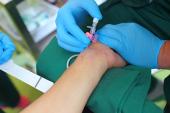Potassium Ferrate Patch Speeds Hemostasis, Discharge After Radial PCI
Whether other hospitals see similar benefits with this type of dressing will depend on their protocols for swift discharge.

PARIS, France—Use of a potassium ferrate hemostatic patch instead of conventional dressings following radial PCI can lead to “substantial” benefits that go beyond trimming the time to hemostasis and discharge plus compression, results from the single-center ARCH trial show.
As lead medical investigator, Claudio Proscia, MD (Liverpool Heart and Chest Hospital, England), explained during a EuroPCR 2022 late-breaking trial presentation today, the hemostatic patch, known as the StatSeal (Biolife), includes a hydrophilic polymer that dehydrates blood and absorbs exudate, while the potassium ferrate agglomerates solids and proteins. Earlier studies, including the recent STAT2 trial, have shown that the hemostatic dressing, in combination with compression, leads to earlier compression removal and fewer vascular complications.
Senior ARCH investigator, Rod Stables, DM, BM BCh (Liverpool Heart and Chest Hospital), told TCTMD that while he’d expected to see a benefit with the patch over standard dressings plus compression, he was “shocked” by the magnitude of the difference, saying that the results have the potential to be practice-changing for his hospital and others.
Lounge Access
The trial was conducted in the “business-class lounge-style” day care facility of Liverpool Heart and Chest Hospital, which is the ward dedicated to same-day discharge patients. As such, said Stables, ARCH would be applicable to other centers that also have swift-discharge protocols following elective or stabilized PCI procedures.
“We wanted to improve the patient’s experience,” Stables explained. “That was the number one aim,” he said. “We wished to reduce the period of hemostasis, which for some patients can be extremely uncomfortable—the pressure is annoying, they have limited mobility, they are always under observation, and can’t be discharged.”
Moreover, he continued, delays to hemostasis and the need for monitoring consume nursing care. Having nurses and clinicians “tied down” with hours of observation ultimately means they have less time for other patients, less time for catching other problems that might arise, and less time for discussing things like rehabilitation and risk factor management.
For lead nursing investigator, Rhian Brown, RN (Liverpool Heart and Chest Hospital), the trial succeeded in what she perceives as its chief aim—namely, “the fact that patients could go home to their own families, to their homes and beds, quicker than before.” Some would have already been in the hospital for several nights, having been transferred from another facility, she noted to TCTMD. “It’s always nice to go home to your own place.”
ARCH Objectives
ARCH set out to randomize 3,000 patients (a mix of elective and stabilized ACS patients transferred from other hospitals) to a conventional dressing with 2-hour compression (the control), to conventional dressing and 1-hour compression, or to the StatSeal hemostatic dressing followed by 1 hour of compression. The TR Band (Terumo) was used for compression in all patients, and dressings were left in place for up to 3 days. The trial was stopped early on the recommendation of the data and safety monitoring board when the hemostatic dressing emerged as the clear front-runner.
Among the 2,114 patients recruited and randomized, just 5.2% of the 708 randomized to the hemostatic patch failed to reach hemostasis within the allotted time period, as compared with 50% of those receiving conventional dressing plus 2 hours of compression (703 patients), and 62% of those with conventional dressing/1-hour compression (703 patients), a statistically significant difference for all comparisons.
Time from randomization postprocedure to complete hemostasis also favored the patch at a median of 72 minutes, as compared with 136 minutes and 166 minutes for the conventional dressings used for 1 and 2 hours, respectively. Adverse outcomes and rates of radial artery occlusion were not significantly different between groups, but rates of discharge delays related to radial care were significantly higher in the conventional-dressing groups.
According to Stables, the trial results still need to be replicated and validated at other centers, but he expects a forthcoming cost-efficacy analysis at Liverpool to show a benefit to the hemostatic dressing, and that it would do so at other places with similar protocols for early discharge.
“We are prepared to discharge a patient 4 hours after PCI, but if you are not and you [aim to discharge] at 8 or 12 hours, then the economic gain won’t be as great. But the proportion of patients who aren’t ready to go home is more with conventional dressings, the number who stay overnight is more, and the number who have to stay extra hours is more: for us there will be a big financial gain, but whether that translates to other hospitals remains to be seen.”
The cost of the dressing in the UK, Stables noted, is “about 20£.”
They investigators plan to work on a cost-modelling analysis that would allow centers to apply the results to their own hospital protocols in order to better understand the cost impact of switching to the hemostatic patch, Proscia noted at the close of his talk.
To TCTMD, he also highlighted the novelty of the “lean, efficient, pragmatic” trial design, with research documentation integrated completely into the electronic medical records, allowing for seamless randomization of patients, who consented before the procedure, before sheath removal at the end.
Although the trial was planned prior to the COVID-19 pandemic and subsequent downturn in PCI procedures, it was able to efficiently enroll a diverse and nonselected group of patients, Proscia added.
During the Q&A, panelists made the point that patch devices like these are likely only needed for PCI patients who have heparin on board and are likely not needed for radial angiography. But Stables, following the session, clarified that heparin 70 units/kg with ACT guidance was used in all cases in ARCH, something he characterized as a “key factor in minimizing subsequent radial artery occlusion.”
In response to a separate question, Proscia acknowledged that a patient satisfaction survey had not been a part of the trial design.
Commenting on the study results for TCTMD, Jordan Safirstein, MD (Morristown Medical Center, NJ), lead author for STAT2, observed that the results of ARCH are “very similar,” with very low rates of radial artery occlusion and low rates of complications in general.
The PCI cohort was larger in ARCH, he noted, because it ultimately included some inpatients, which STAT2 did not. ARCH also showed a considerably faster time to hemostasis.
Commenting on the study results for TCTMD, Jordan Safirstein, MD (Morristown Medical Center, NJ), lead author for STAT2, observed that the results of ARCH are “very similar,” with very low rates of radial artery occlusion and low rates of complications in general.
The PCI cohort was larger in ARCH, he noted, because it ultimately included some inpatients, which STAT2 did not. ARCH also showed a considerably faster time to hemostasis.
Shelley Wood was the Editor-in-Chief of TCTMD and the Editorial Director at the Cardiovascular Research Foundation (CRF) from October 2015…
Read Full BioSources
Proscia C. An RCT to compare conventional and haemostatic dressings in radial access. Assessment of radial artery complications whilst achieving rapid haemostasis: ARCH Trial. Presented at: EuroPCR 2022. May 17, 2022. Paris, France.
Disclosures
- Proscia reports research grants from Biolife, LLC.




Comments